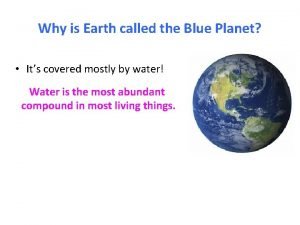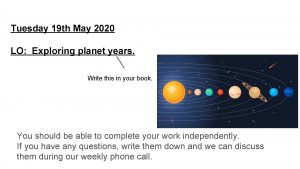Tuesday 12 th May 2020 LO Exploring planet














- Slides: 14

Tuesday 12 th May 2020 LO: Exploring planet days. Write this in your book. You should be able to complete your work independently. If you have any questions, write them down and we can discuss them during our weekly phone call.

Think What is a day?

Day time represents the hours when the sun is up and there is light. A day is the time taken for the Earth to spin on its own axis once. Axis Well done if you remembered this from our lesson on the Sun!

Can you name any of the other planets in our solar system?

Mars Neptune Uranus How many could you name? Venus Mercury Jupiter Saturn

The Sun is the heart of our solar system. It’s gravity holds the system together keeping Earth and the other eight planets in its orbit. Earth and the other seven planets are at different distances from the sun. The nearest planet to the Sun is Mercury. Use the internet to put the planets in order based on their distance from the sun. Start with the nearest planet, Mercury. R a e h t m a p e e h t m s i t i b b r t e o h . r r n e e u b s g m e f e r h o t m a d r n c v Re u e o i r t a y t s l h e v i a s a r t t t e a n a l t p tract s. Write the order of the planets in a list in your book like this: Sun 1. Mercury 2. ____ 3. ____ 4. ____ 5. ____ 6. ____ 7. ____ 8. ____

Your list should like this: Sun 1. Mercury 2. Venus 3. Earth 4. Mars 5. Jupiter 6. Saturn 7. Uranus 8. Neptune This mnemonic can help us to remember the order of the planets from the sun. This video gives some facts about each planet. https: //www. youtube. com/watch? v=m. Qrlg. H 97 v 94

Diameter Above is the planets in the order they are from the sun. Also shown is the diameter of each planet. The diameter is the distance from one side of the planet to the other through its centre. This tells us the planet’s size in kilometres (km). Do you think the length of a day would be the same on each of these planets?

Diameter We know that the length of a day is the time a planet takes to spin once on its axis. Earth takes 24 hours to make one full rotation. Do you think the length of a day would be the same on each of these planets?

Each planet’s axis is tilted at a different angle. The angle of the axis (the centre around which the planet rotates) and the size of the planet both influence how long a planet takes to complete one rotation. So the length of a day is different on each plant.

Activity Use the internet to find the length of a day on each of the planets. You can create a table like the one below in your book and complete this with the length of each day in hours or you could just use the planet names as headings. Planet Length of day in hours Mercury Venus Earth 24 hours Mars Jupiter Saturn Uranus Neptune Try and find this information yourself. If you get really stuck you can follow my link. https: //spaceplace. nasa. gov/days/en/

Activity Mercury Length of day in hours 1, 408 hours Venus 5, 832 hours Earth 24 hours Mars 25 hours Jupiter 10 hours Saturn 11 hours Uranus 17 hours Neptune 16 hours Planet Is there a relationship between day length and the distance the planet is from the sun?

Activity Mercury Length of day in hours 1, 408 hours Venus 5, 832 hours Earth 24 hours Mars 25 hours Jupiter 10 hours Saturn 11 hours Uranus 17 hours Neptune 16 hours Planet There is not a relationship between the distance a planet is from the sun and the length of its day. The length of a planet’s day depends on its size and the speed at which it rotates.

Well done Year 5! I hope you enjoyed learning about the planets in our solar system.



























